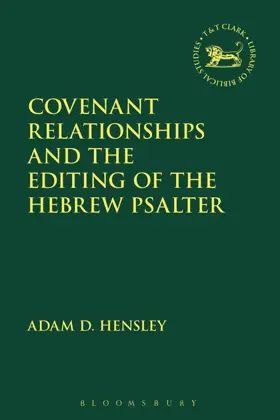

Covenant Relationships and the Editing of the Hebrew Psalter
in Library of Hebrew Bible/Old Testament Studies
Pages
288
Publisher
T&T Clark
Published
5/17/2018
ISBN-13
9780567679109
An examination of the relationship between the Davidic covenant and Abrahamic and Mosaic covenants reflected in the editorial shape and shaping of the Masoretic Psalter. Hensley proposes that the editors of the Psalter understood these covenants as a theological unity, whose common fulfilment centres on an anticipated royal successor to David. To test this hypothesis Hensley examines the Psalter's references and allusions to covenant(s) in light of editorial evidence.
The book is split into three parts. Part I reassesses different kinds of editorial evidence, their implications, and their utility for discerning editorial intent. It also re-evaluates the Qumran Psalms hypothesis championed by Sanders, Wilson, and others. Part II engages in extensive survey work on references and allusions to covenant(s) in the Psalter, assessing the extent to which they gravitate around David. Hensley traces phraseological and intertextual allusions to covenant promises and obligations, providing the first survey of its kind on the subject of covenant in the Psalter. Part III then investigates a strong allusion to the Abrahamic covenantal promises in Ps 72:17 in the context of Book II of the Psalter, and the Psalter's fullest echoes of the “grace formula” (Exod 34:6) in Psalm 86:15, 103:8, and 145:8 in the contexts of Books III, IV, and V respectively.
Hensley shows that rather than the Davidic covenantal promises being “democratized,” the promises and obligations of the pre-monarchic covenants are consistently “royalized” throughout the Psalter and its books, depicting the anticipated Davidic figure as a Moses-like intercessor and mediator of covenant renewal, and the leader of a “new song” for a “new exodus.”
The book is split into three parts. Part I reassesses different kinds of editorial evidence, their implications, and their utility for discerning editorial intent. It also re-evaluates the Qumran Psalms hypothesis championed by Sanders, Wilson, and others. Part II engages in extensive survey work on references and allusions to covenant(s) in the Psalter, assessing the extent to which they gravitate around David. Hensley traces phraseological and intertextual allusions to covenant promises and obligations, providing the first survey of its kind on the subject of covenant in the Psalter. Part III then investigates a strong allusion to the Abrahamic covenantal promises in Ps 72:17 in the context of Book II of the Psalter, and the Psalter's fullest echoes of the “grace formula” (Exod 34:6) in Psalm 86:15, 103:8, and 145:8 in the contexts of Books III, IV, and V respectively.
Hensley shows that rather than the Davidic covenantal promises being “democratized,” the promises and obligations of the pre-monarchic covenants are consistently “royalized” throughout the Psalter and its books, depicting the anticipated Davidic figure as a Moses-like intercessor and mediator of covenant renewal, and the leader of a “new song” for a “new exodus.”
- Table of contents
- Preface
- Foreword
- Acknowledgements
- Note on Translation
- 1. Introduction
- Part I: Editorial Evidence in the Psalter
- 2. Identifying Editorial Evidence in the Psalter
- 3. External Editorial Evidence: Qumran, the LXX, and the Qumran Psalms Hypothesis
- 4. Internal Editorial Evidence
- Part II: An Exploratory Survey of Covenantal References and Allusions in the Psalter
- 5. Previous Survey Work on “Covenant” in the Psalter and Methodological Considerations
- 6. Direct References to Yahweh's Covenant
- 7. David as Yahweh's Faithful Covenant Partner
- 8. David as Keeper of the Mosaic Covenant
- 9. David as New Moses
- Part III: Psalms 72, 86, 103, and 145 in their Book Contexts and Psalms 1–2 as Introduction to the Psalter
- 10. Psalm 72:17 in the Context of Book II
- 11. The Grace Formula in Exodus and the Psalter
- 12. The Grace Formula in Book III (Psalm 86:15)
- 13. The Grace Formula in Book IV (Psalm 103:8)
- 14. The Grace Formula in Book V (Psalm 145:8)
- 15. Ending with the Beginning: Psalms 1–2 as Introduction to the Psalter
- 16. Conclusion
- Appendix: Allusions to the Covenant Formula
- Bibliography
- Index